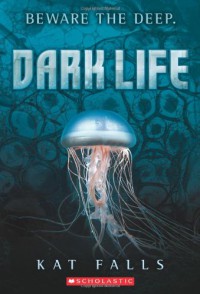Currently reading
Dark Life

***Note: this review assumes that you've read the book.***
One-sentence summary: A simple, wholesome, underwater Little House that reads a lot like a movie--hmm, or maybe a Disney after-school special.
Just fine! I won't have much to say about this book because I didn't read it as a literary entry, I read it for what it is: a solid middle-grade/young-adult crossover fantasy. This is a book that will please its intended audience.
Very visual. The author has a visual way of structuring her prose and plot that's not lyrical, but feels cinematic. It's a great style for upper-MG/lower-YA readers, especially the reluctant kind, even though it doesn't make for terribly nuanced literature. (Which is also just fine.)
Under the sea. It was a refreshing change of pace to have an underwater setting, but with a sort of pioneer/wild-west plot as the underpinning. The settlers even have family names that are reminiscent of American homesteaders of the mid-1800s--a couple of Scandinavian surnames, Anglo-Saxon names, a Chinese family. I enjoyed watching Ms. Falls craft an underwater lifestyle that doesn't depend on an Atlantis-style dome covering everything: "Liquigen" is a clever way to allow humans to breathe underwater when they venture from their structures; there is a nice visual touch in the homes that are flexible in order to sway safely in the currents and are shaped like jellyfish. It's all vaguely based on science, if not entirely not plausible or practical. (For example, how are the homes filled with oxygen? Is it from tanks that they get from the surface? How long would those last before they need to be replenished?)
Dark Life. Similarly, there's a bit of handwaving about the higher pressure affecting developing human brains, so that children raised underwater have special gifts. The gifts vary wildly in their manifestation: Ty can use sonar in the near-black conditions of deep water, and also call dolphins; his younger sister can shock people like an electric eel; a friend has a mental facility with numbers and data and time. Again, not believable, not scientifically explained, but fun!
The world view. A fairly typical blend of environmental calamity due to human activity (global warming) and government corruption. The land masses on the earth have been flooded, so that people who live "above" are crammed into high-density dwellings. Pioneers choose a freer life below the sea, farming fish to feed themselves and those above, with hefty taxes and no rights. The government is corrupt. Kids like Gemma's brother, who are seemingly sent to "boarding schools" are actually sent to prison underwater to conserve valuable dwelling space above.
Manic Pixie Dream Girl. Gemma started out as a MPDG. She redeemed herself somewhat as the story progressed, and certainly had a problem of her own (actually, her problem becomes the focus of the adventure and of the emotional resolution), which is good. But her energy and spunk seemed at first to exist only to impact Ty's life.
Romance. It's kind of dull, and maybe not necessary? In general, the relationship between the two teens and the monotone depth of their individual characters felt a lot like those in Tom McNeal's Far Far Away. But despite McNeal's National Book Award nomination for his title, I actually found Ms. Falls's book to be more entertaining, better paced, and less self-conscious.







